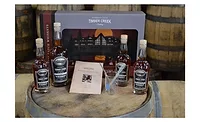Study finds more than 1,300 active craft spirits producers in US
US craft spirits market shows potential for growth
The American Craft Spirits Association (ASCA), International Wine and Spirits Research (IWSR) and Park Street released highlights from the Craft Spirits Data Project at the inaugural Craft Spirits Economic Briefing at the Nomad Hotel in New York. The Craft Spirits Data Project, announced earlier this year, is a research initiative to provide a solid and reliable fact-base for evaluating performance and trends in the U.S. craft spirit industry, the companies say.
The year-long Craft Spirits Project, which seeks to quantify the number, size and impact of craft spirits producers in the United States, is an effort led by ACSA, IWSR and Park Street, with collaboration from key government and industry organizations, including the U.S. Alcohol and Tobacco Tax and Trade Bureau (TTB), the National Alcohol Beverage Control Association (NABCA), American Beverage Licensees (ABL), the Wine & Spirits Wholesalers of America (WSWA), and data partners Acturus, Liquor.com and Nielsen.
For the purposes of the Project, U.S. craft spirits were defined as distilled spirits that are produced in the United States by licensed producers that have not removed more than 750,000 proof gallons from bond, market themselves as craft, are not controlled by a large supplier and have no proven violation of the ACSA Code of Ethics, the companies say.
Key findings announced during the economic briefing include the following:
- The U.S. craft spirits industry is growing rapidly. As of August 2016, there were 1,315 craft distillers active in the United States. The U.S. craft spirits market reached 4.9 million cases and $2.4 billion in retail sales in 2015, growing at a compound annual growth rate (CAGR) of 27.4 percent in volume and 27.9 percent in value between 2010 and 2015. The market share of U.S. craft spirits reached 2.2 percent in volume and 3 percent in value in 2015, up from 0.8 percent and 1.1 percent in 2010, respectively, it says.
- Exports offer an additional runway for growth. Exports of U.S. craft spirits reached 523,000 cases in 2015, adding more than 10 percent of additional volume to U.S. craft distiller total sales.
- Employment and investment are on the rise among craft distillers. Employment in the U.S. craft spirits sector has been on the rise. In 2016, the industry employed more than 12,000 full-time employees. Investments by the U.S. craft industry have reached close to $300 million in 2015, which primarily covered the build-out of tasting rooms and other visitor experiences, equipment to increase production capacity and associated labor costs.
- There is the potential for craft spirits to achieve market share parity with craft beer. Many surveyed retailers and wholesalers see the potential for craft spirits to perform in line or better than craft beer with time. With craft beer market share currently at 11 percent in the United States, the craft spirits market is expected to continue to grow rapidly, the Project notes.
- Direct sales and home-state sales are crucial for small craft spirits producers. Direct sales at the distillery are important for all craft distillers, but are especially important for small craft producers (between zero and 100,000 proof gallons removed from bond annually), where direct sales make up 25 percent of all total sales. Home-state sales outside the distillery for small producers comprise 67 percent of all sales.
- The U.S. craft distilling market remains concentrated. Geographically, the market is concentrated as well. The Top 5 states by number of craft distilleries (California, New York, Washington, Colorado and Texas) make up 35.6 percent of the U.S. craft distiller market, and the next five states (Oregon, Pennsylvania, North Carolina, Ohio and Florida) comprise an additional 16.5 percent of the market, it states.
- Respondents provide actionable recommendations for continued growth. Surveyed distillers, retailers and wholesalers provided actionable recommendations to the U.S. craft spirits industry and its regulators to help the industry continue to grow. Craft spirits producers point to excise tax parity as one of the most critical keys to success in the future. Taxes on distilled spirits are among the nation's highest, comprising 54 percent of the typical spirits product's purchase price. As the Louisville, Ky.-based ACSA previously emphasized, craft spirits producers remain disadvantaged compared with the nation's craft brewers and small wineries that receive a reduction in their Federal Excise Tax (FET) rate. Today, a craft spirits producer pays six times more FET than a craft brewer and 17 times more FET than a small winery for equal quantities of beverage alcohol, it notes.
Looking for a reprint of this article?
From high-res PDFs to custom plaques, order your copy today!






